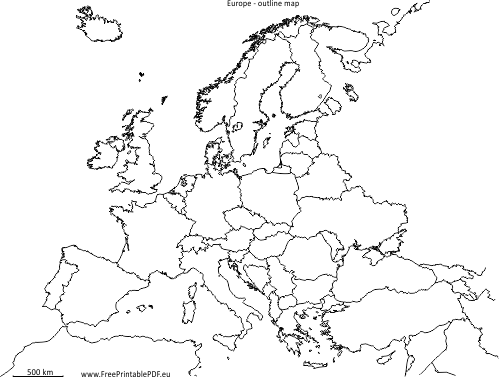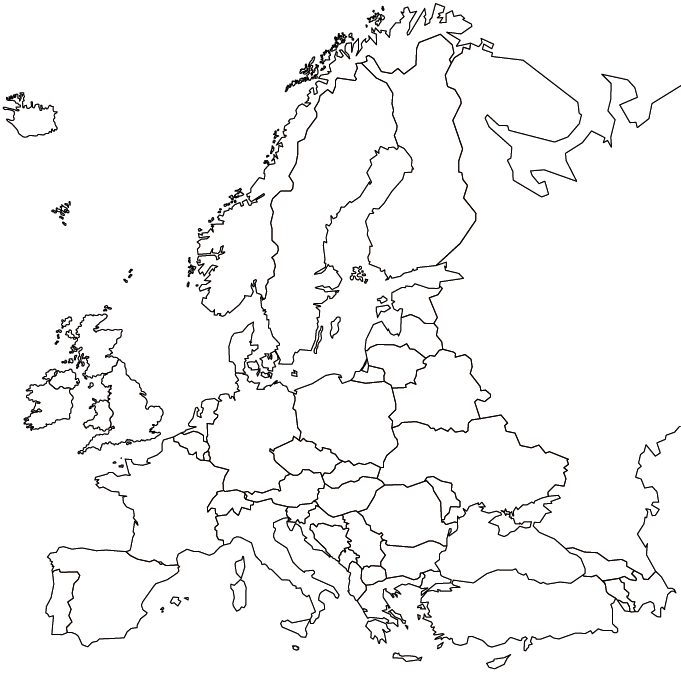Europe Map Outline: A map of any region, country, or continent is useful for various reasons, such as one may use to understand the geography of such area. The other may use it to plan any tour to that particular region, and this is why a map always has significant relevance in many aspects of our lives. You should also look at the large printable maps of the world.
Europe is one of the many continents on Earth, and it is a very significant continent. It has many developed countries such as Russia, Germany, Italy, France and many more. If you want to know about the geographical and political boundaries of all of these countries, then it becomes essential for you to have access to the Europe map outline.
Keeping it as our priority here in this article, we are going to provide you with the Europe map outline, which would help you to have an organized view of the Europe continent while also providing you with the opportunity to shape it with your knowledge.
Table of Contents
Blank Europe Map Outline Printable
Map of Europe Outline with Countries
Regions Of Europe
Political Europe Map Outline
Blank Political Map of Europe Outline
Physical Europe Map Outline
Blank Europe Map Outline Printable

A Europe map outline is a raw or incomplete map in which you are provided with just the outlines of the map, and the rest of the map is completed by the users. It is the complete map of Europe, but it is just made of the systems and misses out on the other information such as the names of the countries, etc., which you can fill yourself with your knowledge.
You can use this map to check your knowledge of the Europe continent and whether you have an idea about the geography of the various countries falling on this continent. The printable version of this Europe map outline is available here.
Map of Europe Outline with Countries
If you need the outlined version of the Europe map outline, then you can get it from here. You can use it in schools or other educational sectors to assess the students’ knowledge of the geography of Europe.
As an outline map, it can also be used as the blank Europe map outline, and you can use it in the same context across various sectors. In this map, we have drawn the outlines of all the countries; you need to fill those outlines with the name of the nations.

Regions Of Europe
Europe is a continent of many peoples, languages, and cultures. Today, more than 748 million people live in Europe. The United Nations’ Geoscheme divides the continent into four subregions: Eastern Europe, Western Europe, Southern Europe, and Northern Europe. Each of these four subregions consists of several countries. Some of these countries are small and sparsely populated, while others are large and heavily populated. Europe’s governments are generally classified as developed countries, though some are more developed than others. It is also important to note that the divisions created by the UN Geoscheme do not necessarily reflect the historical or current divisions of Europe.
-
- Eastern Europe: Eastern Europe is the largest and most populous subregion in Europe, with approximately 292 million people and 18,052,768 sq. km. The Eastern European subregion stretches from the Ural Mountains in the east to the western borders of Poland, the Czech Republic, Slovakia, Hungary, Romania, and Bulgaria. It consists of 10 countries. Russia is by far the largest and most populous country in Eastern Europe. Most of Russia’s landmass, however, is part of Asia, not Europe, as Russia is a transcontinental country and has territory in both Europe and Asia. Russia and the other nine countries that make up the subregion of Eastern Europe once comprised what was commonly known as the Eastern bloc during the Cold War. Russia, Belarus, Moldova, and Ukraine were all republics in the Soviet Union until it collapsed in 1991. Most Eastern Europe is part of the European Union (EU) and NATO. Though the Cold War has long passed, there is still a struggle for influence in Eastern Europe. On one side are NATO and the EU. On the other side is Russia. The EU and NATO seek to further expand into Eastern Europe. At the same time, Russia hopes to halt any further NATO or EU expansion and regain the influence it had over the countries of the subregion during the Cold War.
- Western Europe: Western Europe consists of 9 countries and has a total population of about 196 million. The subregion is home to two of Europe’s most significant political and economic powers, France and Germany. Combined, they contain more than half of Western Europe’s population. Germany is the most populous country in Western Europe, with approximately 83 million, while France has a population of about 63 million. Germany has the world’s fourth-largest economy, while France has the seventh largest economy globally. Formerly bitter enemies, Germany and France, are now the driving force of European integration, especially after the withdrawal of the UK from the EU at the beginning of 2021. Among the other smaller countries of Western Europe are the so-called Low Countries of the Netherlands, Belgium, and Luxembourg.
Further south, on the southern coast of France, is the tiny principality of Monaco, which is distinguished by, among other things, being the most densely populated state on Earth. At much higher elevations are the Alpine countries of Switzerland, Austria, and the tiny principality of Liechtenstein. All the countries of Western Europe, except Switzerland, Monaco, and Liechtenstein, are members of the EU. France, Germany, and the Low Countries are also members of NATO. Western Europe is the home of world-renowned cultural icons. Classical musicians, like Mozart, Beethoven, Debussy, and Chopin. Artists like Van Gogh, Renoir, and Chagall, not to mention some of the world’s greatest orchestras, museums, and galleries.
- Northern Europe: Northern Europe consists of 10 countries. The subregion has a population of about 106 million, making it the least populous of the European subregions. More than half of this population resides in one country, the United Kingdom of Great Britain and Northern Ireland. The UK is the mother country of the once-mighty British Empire, one of the most powerful empires in human history. People used to say that the sun never sets on the British Empire because the British had possessions in every corner of the world. The UK is no longer the juggernaut it once was, but it is still the most populous country in Northern Europe, with nearly 68 million. It also has the subregion’s largest economy, the fifth-largest. The other countries of Northern Europe include the countries of Scandinavia, Finland, the Baltic States, Ireland, and Iceland. The governments of Scandinavia are well-known for their cradle-to-grave welfare states. Sweden is very famous for its many lakes and Norway for its many fjords. Iceland is home to the world’s oldest parliament, the Althing. It is also Europe’s least populous country. Only about 343,000 people live in Iceland. The Baltic States, Latvia, Lithuania, and Estonia, are Northern Europe’s newest countries, having regained their independence upon the collapse of the Soviet Union in 1991. All the nations of Northern Europe, except the UK, Iceland, and Norway, are now part of the EU. Most are also members of NATO.
- Southern Europe: Southern Europe is where much of Europe’s history began. It is where the great, ancient civilisations of Greece and Rome were born. The advancements that these ancient civilisations made in governance, science, architecture, and the arts helped shape Europe and the rest of the world. But Southern Europe is more than just the ruins of ancient civilisations. Today, it is home to 15 countries. Altogether, these countries have a population of approximately 152 million people. The most populous country in Southern Europe is Italy, with more than 60 million people living within its borders. Not too far behind in Spain, which boasts a population of about 46 million. Southern Europe is also home to the world’s smallest and least populous country, Vatican City, with less than a thousand inhabitants. Some of Europe’s most recent armed conflicts have occurred in Southern Europe, notably in the Balkans. The breakup of Yugoslavia in the 1990s resulted in much bloodshed. Fortunately, however, this bloodshed eventually gave way to happier times. Today, most Balkan states are part of the EU and NATO, as are most Southern Europe countries. Southern Europe is also home to Europe’s biggest city, Istanbul, though ironically, much of Istanbul and its population technically reside in Asia.
- Central Europe: Central Europe is not part of the UN Geoscheme for Europe. Moreover, although the concept of Central Europe exists both historically and currently, there is no consensus as to which countries should be considered part of it. For the sake of argument, it is probably safe to say that there are up to 9 countries that could be regarded as part of Central Europe. Germany, Poland, the Czech Republic, Slovakia, Hungary, Liechtenstein, Slovenia, Austria, and Switzerland. All these countries are part of different subregions of Europe as defined by the UN Geoscheme. Thus, Central Europe is a European crossroads of sorts, where other languages and cultures of the continent meet. The region, for example, is home to both Slavic-speaking states like the Czech Republic, Slovakia, and Poland, as well as German-speaking states like Germany, Austria, and Switzerland. Central Europe also contains countries on different sides of the east-west divide during the Cold War. Just as it is in Western Europe, Germany is also the largest and most populous country in Central Europe. Indeed, Germany has always figured prominently in the history of Central Europe, beginning with the Holy Roman Empire that controlled much of the region in medieval times.
Political Map of Europe Outline
A political map of Europe not just describes the geographical characteristics of the continent but also shows the political boundaries. Political boundaries are related to the ruling of one government in a particular region or the country of Europe.
This kind of map is helpful for people who want to have political knowledge of Europe. You can use it in your political way or even in the educational institutions to impart the political understanding of Europe to the students. You can print this template of the European map in your desired format.

Blank Political Map of Europe Outline
A blank political map of Europe is provided with only country borders, allowing readers to exercise their geography skills by colouring or writing the names of countries and water features found in Europe. The political map of Europe shows countries and cities, bordering countries, peninsulas and islands surrounded by oceans and seas, and more.
Physical Map of Europe
This map depicts Europe’s physical landscape. There are several significant mountain ranges in the area. The Pyrenees serve as a border between Spain and France. The Alps are a mountain range that separates Italy from the countries to the north. The Central Massif is in southwest France. The Pindus and Rhodope Mountains are in Greece. Georgia and Azerbaijan are separated from Russia by the Caucasus Mountains.
Carpathian Mountains and the Transylvanian Alps can be found in Eastern Europe. Most physical geographers believe the Ural Mountains to be the separating range between Europe and Asia, as they run north-south through Russia.
The Caspian Sea, Black Sea, Aegean Sea, Ionian Sea, Adriatic Sea, Mediterranean Sea, Balearic Sea, Alboran Sea, Bay of Biscay, Celtic Sea, English Channel, North Sea, Norwegian Sea, Baltic Sea, Barents Sea, White Sea, and the Gulf of Bothnia are some of the major bodies of water.

